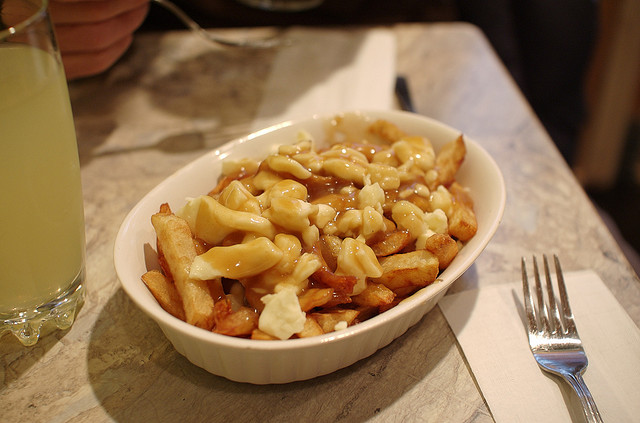A Quick Guide to Québécois Food
TIME : 2016/2/16 15:39:18

A classic poutine. Photo © JoePhoto, licensed Creative Commons Attribution.
Over the past 400 years or so Québec has developed its own cuisine; some foods are variations on old French recipes and some are creations that are uniquely their own. In the early days of the colony much of Québec society relied on hunting and fishing for sustenance, and wild game is still a big part of cooking in the region. Here’s a quick guide to some of the more common but obscure foods you may come across.
- Caribou: This is one of the more popular meats, and you’ll find it on menus across the city. It’s an especially popular ingredient in meat pies.
- Caribou (the drink): During the city’s world-famous annual Winter Carnival this stuff is available in all the SAQs (liquor stores). This mixture of port, vodka, black-currant liqueur, and maple syrup might be tough to get down but it will keep you warm and give you enough courage to tackle les glissades—the enormous toboggan run on Terrasse Dufferin.
- Cheese Curds: This is the special cheese they put on top of poutine, but it is also eaten on its own as a snack and can be found at most corner stores. Made from fresh cheddar, it has a rubbery texture and squeaks when it’s chewed.
- Cheval: Though it’s not as common a meat here as in Belgium, horse can still be found on menus across the city, mostly likely listed as bavette de cheval, horse steak. Similar to beef in consistency, it is both sweeter and more tender.
- Cretons: If you order a traditional Québécois breakfast, there’s a good chance you’ll find a serving of this on your plate. A salty pork product, it’s made by boiling the pork in milk with onions and spices until its consistency is halfway between a spread and a pâté. It’s best eaten on toast.
- Foie Gras: Made from duck and goose liver (the name literally means “fatty liver”), this typical French dish has turned into an industry in Québec. Locally produced foie gras is now a staple in most bistros and restaurants serving haute cuisine.
- Galvaude: A variation on poutine, this dish adds chicken and peas to the fries, gravy, and cheese for a more “rounded” meal.
- Grand-père dans le Sirop: A popular dessert during the Great Depression, this is essentially a sweet dumpling made by boiling batter in sugar water, then serving it doused with maple syrup. Translated it means “Grandpa in the syrup.”
- Guedille: Found mostly in cassecroûtes (snack shacks), guedilles are hot dog buns stuffed with lettuce, mayonnaise, and just about anything else, including egg, chicken, and fries. Commonly found outside of the cities, it’s one version of Québec’s take on fast food.
- Oreilles de Crisse: Translated this means “Christ’s ears.” Made from fried salted pork, they’ve been a snack since the time of Nouvelle France. Variations on this can be found in upscale restaurants across the province, especially those that specialize in terroir cooking.
- Poutine: Fries, gravy, cheese curds—this is the unofficial national dish of Québec. Though poutine has recently been embraced by food lovers everywhere, it was invented in this region and remains close to locals’ hearts.
- Ragoût de Pattes de Cochon: This stew made with pig’s feet is part of the réveillon, or Christmas meal. A variation on this includes ragoût de boulettes, which means meatballs, though likely made with pork and not beef.
- Tourtière: Otherwise known as meat pie, this is likely the most common of all the dishes as well as the oldest. Records show that it was first being made in Québec as early as 1611. It’s usually made with beef or pork, but different regions in the province have different versions. In Montréal, it’s a shallow pie filled with ground pork, while in the Lac-Saint-Jean region, north of Québec City, the pie is deeper and made with wild game like moose, caribou, elk, and hare. It’s called cipaille in most restaurants.
Excerpted from the Third Edition of Moon Montréal & Québec City.
